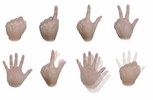




Screen-less wearable devices allow for the smallest form factor and thus the maximum mobility. However, current screen-less devices only support buttons and gestures. Pointing is not supported because users have nothing to point at. However, we challenge the notion that spatial interaction requires a screen and propose a method for bringing spatial interaction to screen-less devices.
We present Imaginary Interfaces, screen-less devices that allow users to perform spatial interaction with empty hands and without visual feedback. Unlike projection-based solutions, such as Sixth Sense, all visual "feedback" takes place in the user's imagination. Users define the origin of an imaginary space by forming an L-shaped coordinate cross with their non-dominant hand. Users then point and draw with their dominant hand in the resulting space.
With three user studies we investigate the question: To what extent can users interact spatially with a user interface that exists only in their imagination? Participants created simple drawings, annotated existing drawings, and pointed at locations described in imaginary space. Our findings suggest that users' visual short-term memory can, in part, replace the feedback conventionally displayed on a screen.


We describe techniques for direct pen+touch input. We observe people's manual behaviors with physical paper and notebooks. These serve as the foundation for a prototype Microsoft Surface application, centered on note-taking and scrapbooking of materials. Based on our explorations we advocate a division of labor between pen and touch: the pen writes, touch manipulates, and the combination of pen + touch yields new tools. This articulates how our system interprets unimodal pen, unimodal touch, and multimodal pen+touch inputs, respectively. For example, the user can hold a photo and drag off with the pen to create and place a copy; hold a photo and cross it in a freeform path with the pen to slice it in two; or hold selected photos and tap one with the pen to staple them all together. Touch thus unifies object selection with mode switching of the pen, while the muscular tension of holding touch serves as the "glue" that phrases together all the inputs into a unitary multimodal gesture. This helps the UI designer to avoid encumbrances such as physical buttons, persistent modes, or widgets that detract from the user's focus on the workspace.




Touch is a compelling input modality for interactive devices; however, touch input on the small screen of a mobile device is problematic because a user's fingers occlude the graphical elements he wishes to work with. In this paper, we present LucidTouch, a mobile device that addresses this limitation by allowing the user to control the application by touching the back of the device. The key to making this usable is what we call pseudo-transparency: by overlaying an image of the user's hands onto the screen, we create the illusion of the mobile device itself being semi-transparent. This pseudo-transparency allows users to accurately acquire targets while not occluding the screen with their fingers and hand. Lucid Touch also supports multi-touch input, allowing users to operate the device simultaneously with all 10 fingers. We present initial study results that indicate that many users found touching on the back to be preferable to touching on the front, due to reduced occlusion, higher precision, and the ability to make multi-finger input.